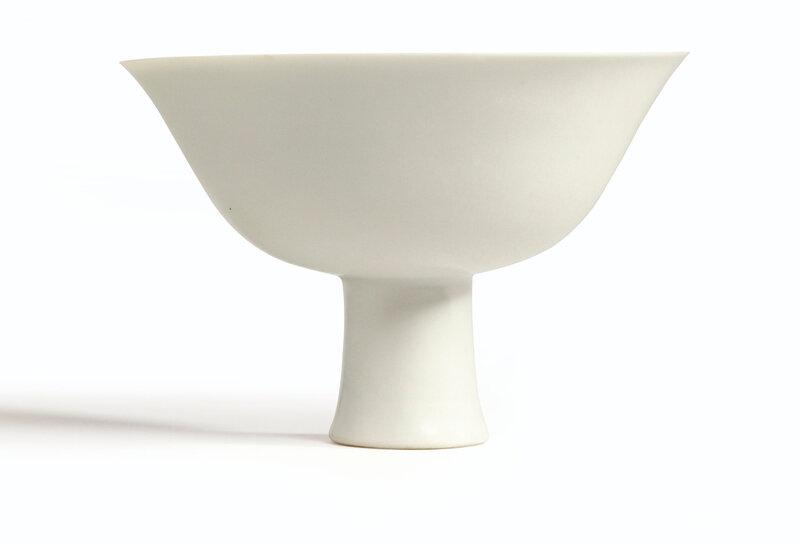An Exceptionally Rare Anhua-Decorated White Stembowl, Incised Mark and Period of Yongle
Lot 8. An Exceptionally Rare Anhua-Decorated White Stembowl, Incised Mark and Period of Yongle (1403-1435); diameter 15 cm., 5 7/8 in. Estimate 2,700,000 - 4,500,000 HKD (266,583 — 444,306 EUR). Lot sold 5,080,000 (501,572 EUR). Courtesy Sotheby's
thinly potted, the wide flared bowl resting on a narrow stem splayed toward the base, subtly decorated around the interior walls in faint anhua with the bajixiang ('Eight Buddhist Emblems'), each supported on a lotus flower issuing from a scrolling leafy stem, and further applied overall with a 'sweet-white' (tianbai) glaze of warm milky tone, save for the footring left unglazed, the interior inscribed in anhua with a four-character archaic reign mark within a medallion of petal panels.
EXHIBITED: Chinese Ceramics from the Meiyintang Collection, The British Museum, London, 1994.
Evolution to Perfection. Chinese Ceramics from the Meiyintang Collection/Evolution vers la perfection. Céramiques de Chine de la Collection Meiyintang, Sporting d’Hiver, Monte Carlo, 1996, cat. no. 107.
LITTERATURE: Regina Krahl, Chinese Ceramics from the Meiyintang Collection, London, 1994-2010, vol. 2, no. 652.
NOTE: Yongle porcelains inscribed with the imperial reign mark are extremely rare. Imperial reign marks were first used during the Yongle period, and were inscribed both on Buddhist gilt-bronze images and on porcelains used in Buddhist rituals, namely monochrome white and red stembowls and white monks’ cap ewers. On porcelains the mark is always in archaic script and in the four-character form, and has been traced by Liu Xinyuan to the style of the court calligrapher Shen Du, whom the Yongle Emperor is said to have greatly admired; see the exhibition catalogue Imperial Porcelain of the Yongle and Xuande Periods Excavated from the Site of the Ming Imperial Factory at Jingdezhen, Hong Kong Museum of Art, Hong Kong, 1989, pp. 40f. and 74f.
Fragments of numerous monochrome ‘sweet-white’ stembowls of Yongle mark and period have been recovered from the waste heaps of the Ming imperial kiln site, both in the early and the late Yongle stratum. The mark is always inscribed on the inside of the bowl, either in the centre or on the sides, and can be incised or impressed in anhua technique. A reconstructed stembowl and three sherds from the early Yongle stratum of the kiln site were included in the exhibition Jingdezhen chutu Ming chu guanyao ciqi/Imperial Hongwu and Yongle Porcelain Excavated at Jingdezhen, Chang Foundation, Taipei, 1996, cat. nos. 110 and 158-60.
A white Yongle stembowl with the mark on the inner sides in the British Museum is illustrated in Jessica Harrison-Hall, Ming Ceramics in the British Museum, London, 2001, no. 3: 1.
Sotheby's. The Meiyintang Collection- www.sothebys.com

/https%3A%2F%2Fprofilepics.canalblog.com%2Fprofilepics%2F1%2F0%2F100183.jpg)
/https%3A%2F%2Fstorage.canalblog.com%2F03%2F02%2F119589%2F96711876_o.jpg)
/https%3A%2F%2Fstorage.canalblog.com%2F11%2F31%2F119589%2F94773502_o.jpg)
/https%3A%2F%2Fstorage.canalblog.com%2F20%2F83%2F119589%2F94772815_o.jpg)
/https%3A%2F%2Fstorage.canalblog.com%2F26%2F72%2F119589%2F75604929_o.jpg)
/https%3A%2F%2Fstorage.canalblog.com%2F59%2F60%2F119589%2F26458628_o.jpg)





/http%3A%2F%2Fstorage.canalblog.com%2F13%2F16%2F119589%2F126295343_o.jpg)
/http%3A%2F%2Fstorage.canalblog.com%2F91%2F38%2F119589%2F126290740_o.jpg)
/http%3A%2F%2Fstorage.canalblog.com%2F46%2F37%2F119589%2F121359289_o.jpg)
/http%3A%2F%2Fstorage.canalblog.com%2F46%2F16%2F119589%2F121134597_o.jpg)